Sundry Photography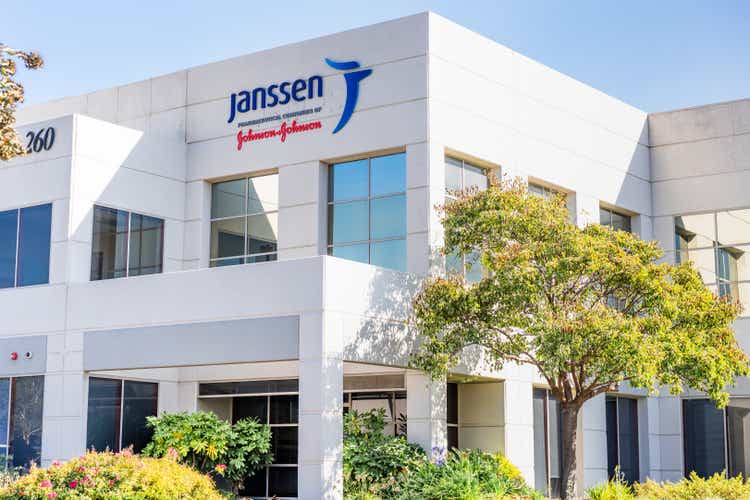
Johnson & Johnson (NYSE:JNJ) has been in our family portfolio for over five years. With a relentless focus on owning enduring companies whose shares are bought at value prices, JNJ stands out as a premier health care sector core holding in any quality-focused portfolio.
I had initially covered JNJ on Seeking Alpha in an Editor’s Pick article in May of 2017.
In this updated primary ticker research report, I put Johnson & Johnson and its common shares through my market-beating, data-driven investment research checklist of the value proposition, shareholder yields, fundamentals, valuation, and downside risk.
The resulting investment thesis:
After the pending consumer healthcare segment spinoff, Johnson & Johnson, the company, will remain a diverse and defensive pharmaceuticals and medical technologies provider with growing dividends and low downside risk. However, JNJ, the stock, is currently trading at a premium.
My current overall rating: Bullish on the company. Neutral on the stock.
Unless noted, all data presented is sourced from Seeking Alpha and YCharts as of the intraday market on July 14, 2022; and intended for illustration only.
The Blue Chip Of Health Care Products
Johnson & Johnson is a dividend-paying large-cap stock in the health care sector’s pharmaceuticals industry.
Together with its subsidiaries, Johnson & Johnson researches, develops, manufactures, and sells various products in the healthcare field worldwide. The company was founded in 1886 and is based in New Brunswick, New Jersey, USA.
My value proposition elevator pitch for Johnson & Johnson:
Like owning a health care mutual fund but with blue chip low risk.
The chart below illustrates the stock’s performance against the iShares U.S. Pharmaceuticals ETF (NYSE:IHE), the Health Care Select Sector SPDR® Fund ETF (NYSE:XLV), and the SPDR S&P 500 ETF Trust (NYSE:SPY), since adding the shares to our family portfolio on May 8, 2017.
Ultimately, investing in individual common stocks should aim to beat the benchmark indices over time. For example, JNJ has convincingly outperformed the total return of its industry but has lagged the sector and broader market.
My value proposition rating for JNJ: Bullish.
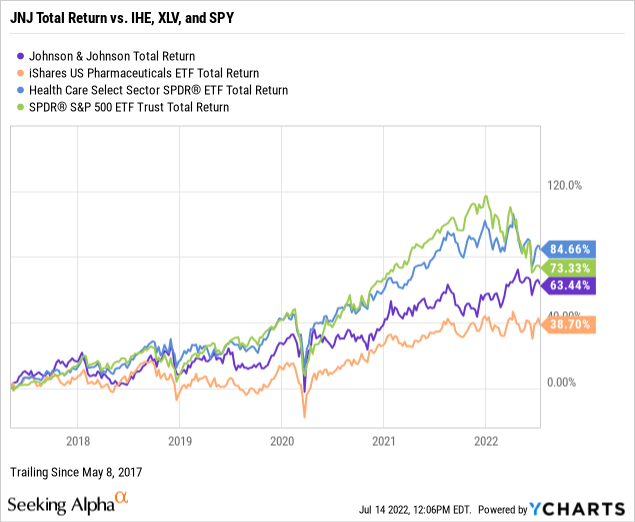
A Well-Covered Safe Dividend
As part of your due diligence, average the total shareholder yields on earnings, free cash flow, and dividends to measure how a targeted stock compares to the prevailing yield on the 10-year Treasury benchmark note. In other words, what is the equity bond rate of the common shares?
Target an earnings yield greater than 6 percent or the equivalent P/E multiple below 17 times. JNJ is under the floor at 4.25%, as demonstrated in the below chart.
Target a free cash flow yield or FCFY of 7 percent and higher or the equivalent of fewer than 15 times the inverted price-to-free cash flow multiple. At 4.23%, JNJ is under the threshold.
Whether or not you are a dividend investor, consider dividend-paying stocks for compensation in the short term while waiting for capital gains to compound over time. Johnson & Johnson offers a dividend yield of 2.47% with a moderate 42.91% payout ratio, below my 60% payout ratio ceiling, thus indicating a well-covered dividend with room for increases.
Avoid the unnecessary risks of high dividend yield investing unless calculated on a cost basis. For example, JNJ was yielding 4.21% on our adjusted cost basis of $107.35 per share since May of 2017, or 174 basis points above the forward yield. Another reminder that buy and hold quality value investing works.
Next, take the average of the three shareholder yields to measure how the stock compares to the prevailing yield of 2.96% on the 10-year Treasury benchmark note. The average shareholder yield for JNJ was 3.65% or 4.23% using the stock’s dividend yield on cost. Arguably, equities are deemed riskier than U.S. bonds. However, securities that reward shareholders at higher yields than the government benchmark, especially core holding shares such as JNJ, favor owning the stock instead of the bond.
Remember that earnings and free cash flow yields are inverse valuation multiples, suggesting that JNJ is trading at a premium. I’ll further explore valuation later in this report.
My shareholder yields rating for JNJ: Bullish.
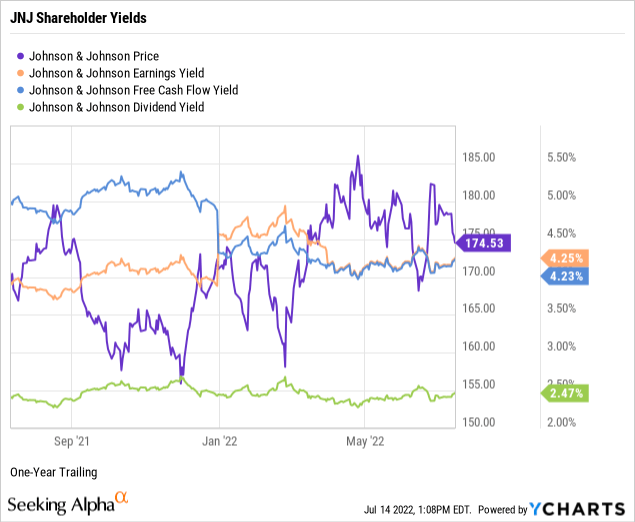
Superior Returns On Management
Let’s explore the fundamentals of Johnson & Johnson, uncovering the performance strength of the company’s senior management.
When analyzing a business, stay biased toward established growth instead of executive guidance and sell-side analyst projections. For example, per the below chart, Johnson & Johnson had three-year revenue growth of 4.95%, in line with the 5.80% median growth for the health care sector.
Johnson & Johnson had a trailing three-year pre-tax net profit margin of 20.90%, far exceeding the sector’s negative median net margin of -1.65%. Remember, screen for profitable companies to avoid unnecessary speculation. J & J’s double-digit margin is notable.
Return on equity or ROE reveals how much profit a company generates from shareholder investment in the stock. Target an ROE of 15 percent or higher to discover shareholder-friendly management. For example, Johnson & Johnson was producing trailing three-year returns on equity of 27.98% against a negative median ROE of -35.82% for the sector. Subsequently, J & J’s compelling profitability provides excellent returns on equity.
Target a return on invested capital or ROIC above 12%. At 18.98%, Johnson & Johnson exceeds the threshold and the sector’s negative median ROIC of -19.74%, indicating that J & J’s senior executives are superb capital allocators. Return on invested capital measures how well a company invests its resources to generate excess returns.
ROIC needs to exceed the weighted average cost of capital or WACC by a comfortable margin, showcasing management’s ability to outperform its capital costs. J & J had a trailing WACC of 6.17% (Source: GuruFocus). The sufficient spread between ROIC and WACC combined with positive growth, a double-digit net profit margin, and compelling returns on equity and capital indicate superior management performance at Johnson & Johnson.
My fundamentals rating for JNJ: Bullish.
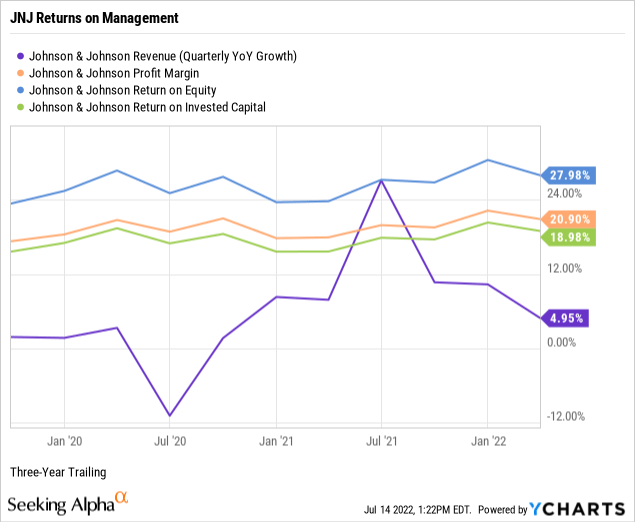
Premium-Priced Shares
I rely on just four valuation multiples to estimate the intrinsic value of a targeted quality enterprise’s stock price.
The price-to-sales ratio or P/S measures the stock price relative to revenues. Target fewer than 2.0 times, and at 4.92, JNJ was trading far above the ceiling. In addition, the trailing P/S ratio was a similar 4.64 times for the health care sector and a more attractive 2.27 times sales for the S&P 500. Thus, the weighted industry plus market sentiment suggests an overvalued stock relative to Johnson Johnson’s topline.
Remember, bargain price-to-sales ratios for JNJ are rare with its predictable revenues and growth.
Although often a hit or miss multiple, target price-to-trailing earnings or P/E multiples fewer than 17 times or below the target stock’s sector averages. JNJ had a price-to-earnings multiple of 23.56 against a sector P/E of 27.44, indicating investor sentiment fairly values the stock price relative to earnings per share. Notably, JNJ was trading at a slight premium to the S&P 500’s recent overall P/E of 21.07 times. (Source of S&P 500 P/E: Barron’s).
Target single-digit price-to-operating cash flow multiples for the best value. At 20.03 times, JNJ was trading at twice the ceiling and above the sector’s median of 18.54, indicating the market places a premium on the stock price relative to current cash flows.
Enterprise value to operating earnings or EV/EBIT measures whether a stock is overbought, a bearish signal, or oversold, a bullish signal, by the market. Target an EV/EBIT of fewer than 15 times. Against the broader sector median of 20.25 times, JNJ was trading at 21.75 enterprise value to operating earnings signaling the stock was somewhat overbought or undersold by the market.
Weighting the preferred valuation multiples suggests the market places a premium on Johnson & Johnson’s stock price to sales, earnings, cash flow, and enterprise value. Therefore, based on the fundamentals and valuation metrics uncovered in this report, risks and potential catalysts notwithstanding, I would call JNJ a premium-priced stock of an enduring quality operator within the health care sector.
My valuation rating for JNJ: Neutral.
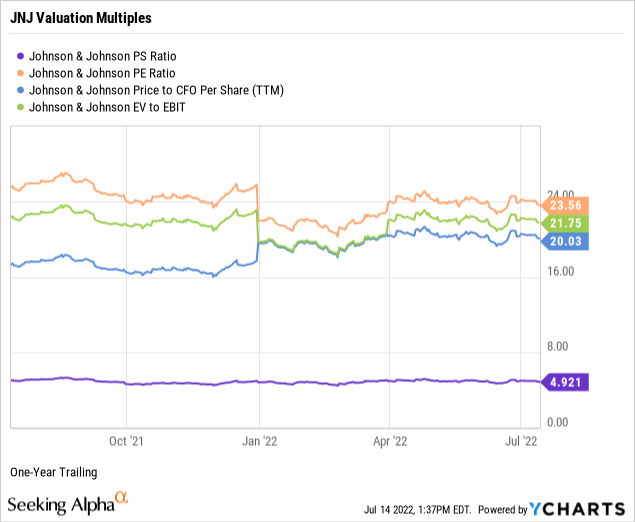
Coveted Low Downside Risk
When assessing the downside risks of a company and its common shares, focus on five metrics that, in my experience as an individual investor and market observer, often predict the potential risk/reward of the investment. Hence, assign a downside risk-weighted rating of above average, average, below average, or low, biased toward below average and low-risk profiles.
Alpha-rich investors target companies with clear competitive advantages from their products or services. An investor or analyst can streamline the value proposition of an enterprise with an economic moat assignment of wide, narrow, or none.
For example, Morningstar assigns Johnson & Johnson a wide moat rating.
We believe Johnson & Johnson carries one of the widest moats in the healthcare sector, supported by intellectual property in the drug group, switching costs in the device segment, and strong brand power from the consumer group. The company’s diverse revenue base, strong pipeline, and robust cash flow generation create a very wide economic moat. An extensive salesforce makes J&J a powerful candidate for a smaller biotechnology company looking to partner on a new drug, which strengthens Johnson & Johnson’s ability to bring new products to market.
– Damien Conover, CFA, Sector Director, June 20, 2022
A favorite of the legendary value investor Benjamin Graham, long-term debt coverage demonstrates balance sheet liquidity or a company’s capacity to pay down debt in a crisis. Generally, at least one-and-a-half times current assets to long-term debt is ideal. Notably, as reported on its April 2022 quarterly financial statements, Johnson & Johnson’s long-term debt coverage of 2.09 was comfortably above the threshold.
In theory, the company could pay off its longer-term debt obligations in a crisis using its liquid assets such as cash and equivalents, short-term investments, accounts receivables, and inventory.
Current liabilities coverage or current ratio measures the short-term liquidity of the balance sheet. Target higher than 1.00, and Johnson & Johnson’s short-term debt coverage was 1.39. So again, J & J’s balance sheet provides sufficient liquid assets to pay down 100% of its current liabilities, including accounts payable, accrued expenses, short-term borrowings, and income taxes.
As a long-term investor, use a five-year beta trend line and screen for stocks lower than 1.25 or no more than 125% volatility in the market. JNJ’s trailing beta was 0.63, and its shorter-term 24-month beta was a less volatile 0.53. With price volatility well below the S&P 500 standard of 1.00, JNJ presents a stable core holding across market cycles.
The short interest percentage of the float for JNJ was 0.54%, well under my 10% ceiling. So perhaps the near-sighted bears view the stock as a safe, predictable revenue and cash flow staple in the pharmaceuticals and health care equipment industries.
Despite its stock’s high valuation multiples, Johnson & Johnson is a fundamentally sound, super wide moat company with an appealing risk profile.
My downside risk rating for JNJ: Low.
JNJ: A Health Care Sector Core Holding
Catalysts confirming or contradicting my overall bullish investment thesis on Johnson & Johnson and its common shares include, but are not limited to:
- Confirmation: Even after the consumer healthcare segment spinoff, JNJ remains a diverse and defensive pharmaceuticals and medical technology provider with growing dividends and low downside risk.
- Contradiction: Potential legal liabilities from its talc powder products and the domestic opioid crisis could continue to hinder senior management and the balance sheet.
I believe that any quality-focused portfolio should include JNJ as a core health care sector holding. Nonetheless, the stock is currently a bit pricey, and new investors should wait to see if the bear continues to roam, potentially knocking the price to value levels.



Be the first to comment